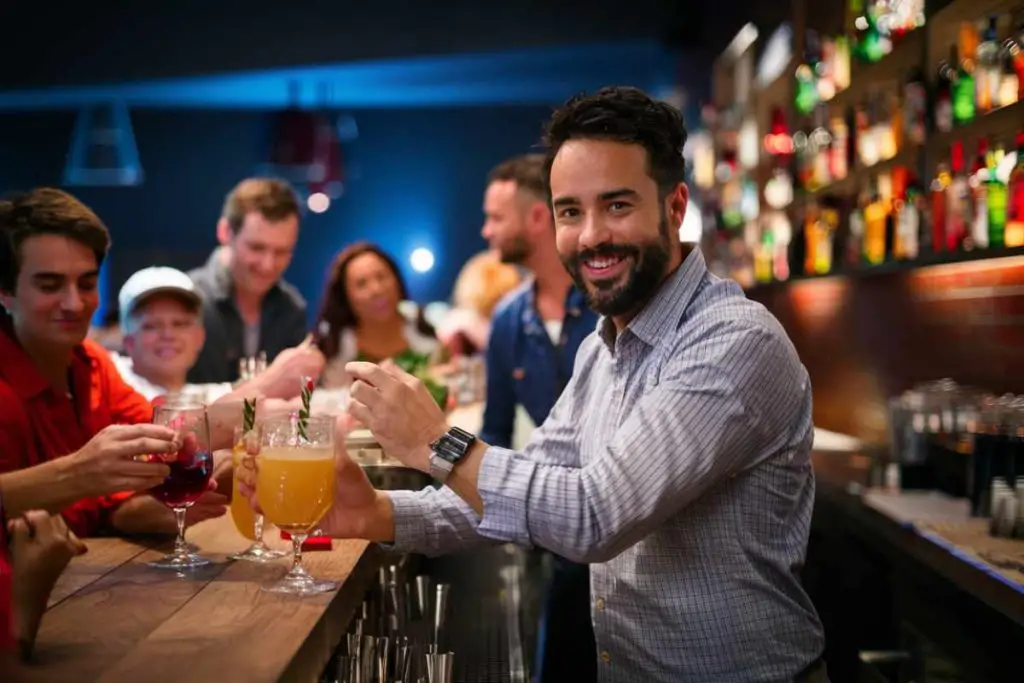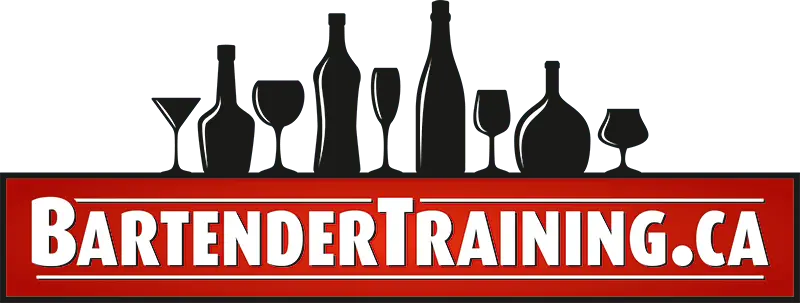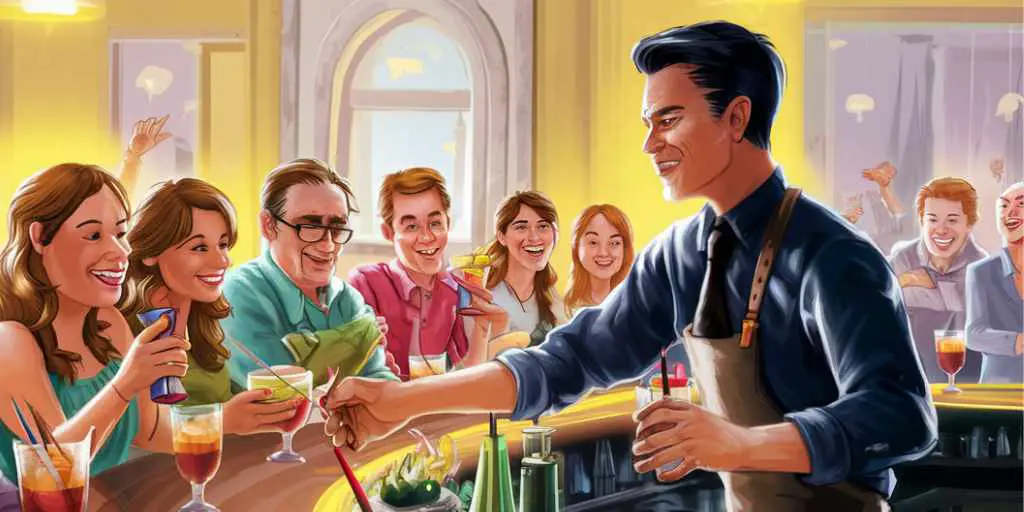Here’s the secret: great bartenders don’t just sling drinks. They create experiences. This guide will unlock proven strategies to transform you from an order taker into a tip-generating master. Learn how to build rapport, deliver exceptional service, and become the bartender everyone wants to see behind the bar. Get ready to watch your tips soar!
Mastering the Basics of Bartending
Mastering fundamental bartending skills and understanding drink recipes are essential for any bartender aiming to increase their earnings through tips. Excelling in these basics streamlines service and enhances the customer experience.
Learning Essential Bartending Skills
Bartenders must develop a solid foundation of essential skills to handle the typical rush of a busy bar effectively. This includes mastering the proper pouring, shaking, stirring, and muddling techniques. Proficiency in these methods ensures consistent and high-quality drinks every time. They should also be adept at using bar tools, such as jiggers for accurate measuring, shakers for blending ingredients, and strainers for achieving the desired drink clarity.
- Pouring: Accurate pouring controls liquor cost and drink quality.
- Shaking: Essential for cocktails that require emulsification.
- Stirring: For drinks where clarity and smoothness are desired.
- Muddling: Required for releasing flavours from herbs and fruits.
A bartender’s ability to provide quick and polite service, keep their workspace clean, and manage the bar’s inventory will conjure an inviting atmosphere, which in turn can lead to increased tips. A bartender must also be capable of multitasking, managing their time, and maintaining poise during peak hours.
Understanding Drink Recipes and Menus
A proficient bartender must be intimately familiar with the bar’s menu and be able to prepare all the drinks it contains. This encompasses a broad knowledge of cocktail recipes, an understanding of different types of beer and wine, and the ability to craft both classic and innovative drinks. They should be prepared to answer questions about flavor profiles and offer recommendations based on the customers’ preferences.
- Cocktail Recipes: Knowledge of both classic and trendy mixes.
- Beer: Awareness of various beer styles and brewing methods.
- Wine: Understanding of basic wine characteristics and pairings.
Discerning and suggesting suitable drink options for customers can create personalized experiences that encourage better tips. Additionally, explaining the nuances of different drinks or suggesting food pairings reflects a bartender’s expertise and can substantially enhance customer satisfaction.
Enhancing Customer Interaction
The key to securing better tips lies in the bartender’s ability to provide excellent customer service through enhanced interaction. Every gesture and conversational exchange should be an opportunity to solidify a positive connection with the guest.
Using Positive Body Language
Positive body language is a cornerstone of great service that can lead to good tips. Bartenders should greet guests with a warm smile and make regular eye contact, indicating attentiveness. To convey professionalism, movements should be confident and deliberate, whether mixing a cocktail or presenting a beverage.
Building Rapport Through Conversation
Engaging in conversation with a customer is more than small talk; it’s about creating a genuine connection. Bartenders should listen actively and pick up on topics the guest is interested in, using this information to steer the conversation and make the customer feel valued and understood.
Recognizing and Treating Regulars
Regular guests are the backbone of any establishment. Bartenders should remember their preferences, greet them by name, and treat them with the familiarity and respect that acknowledges their importance. Recognizing and treating regulars well strengthens loyalty and often results in consistently better tips.
Improving Service Quality
To garner greater tips, bartenders must excel in customer interaction and efficiency. Striking the right balance between personalized attention and swift service often leads to more satisfied guests and, as a result, better tips.
Offering Personalized Customer Experience
Customers in the hospitality industry expect more than just a drink; they desire a memorable experience. Bartenders who remember a guest’s name or their preferred drink show a level of care that resonates well with patrons. For example, greeting a repeat customer with “Would you like your usual Manhattan, John?” directly impacts the level of great service perceived. Personal touches like these often lead to better tips.
- Acknowledge Regulars: Recognize repeat guests with a warm welcome.
- Learn Preferences: Note customers’ favourite drinks for future visits.
Maintaining Efficiency During Service
Efficiency is critical for a good bartender, as swift and accurate service prevents customer frustration and maintains the establishment’s flow. Implementing organized systems, such as grouping similar drink orders and mastering the art of multitasking, can substantially increase the speed of service without compromising quality. This aspect of great service encourages guests to leave great tips.
- Streamline Tasks: Arrange bar tools for optimal movement and sequence tasks intelligently.
- Practice Multitasking: Balance multiple orders simultaneously while ensuring quality.
Cultivating a Professional Image
In the competitive hospitality industry, bartenders who present a polished professional image can significantly increase their tip earnings. An impeccable appearance and an organized workspace not only impress patrons but also reflect a commitment to quality and service.
Dressing for Success
A bartender’s attire is a critical element of their professional image. They should select clothing that is both functional and fashionable. Neatness is paramount, with a preference for clothes that resist stains and remain presentable throughout a shift. It is advisable for bartenders to adhere to any specific dress codes required by the bar, but they can also add a subtle personal touch, like a unique tie or a sleek apron, to stand out.
Maintaining a Clean and Organized Bar Space
A clean and organized bar space is essential to a good bartender’s workday. Patrons are more likely to trust and tip bartenders who work in well-maintained environments. This includes regularly wiping down the bar, arranging bottles and glasses in an orderly fashion, and ensuring tools are sanitized and neatly stored. Not only does an orderly space make for a more efficient service, but it also conveys professionalism and a dedication to guests’ enjoyment.
Upselling and Suggestive Selling
In the world of bartending, a bartender’s income can substantially increase through effective upselling and suggestive selling techniques. These strategies not only boost sales but can also significantly raise tip amounts. By introducing premium spirits and carefully suggesting pairings and add-ons, a bartender can enhance the customer’s experience and, as a result, receive a larger tip.
Introducing Premium Products
A bartender should always be familiar with the inventory, especially high-margin premium products. When a customer orders a cocktail, it’s opportune to suggest a top-shelf liquor instead of a standard option. This can be done by enlightening the customer about the superior quality and flavor profile of the premium spirit. For example, if a customer orders a gin and tonic, the bartender might suggest a gin with a distinctive botanical blend to elevate the drink. By recommending higher-priced items that enhance the drinking experience, a bartender increases the bill and often the tip amount.
Suggesting Pairings and Add-ons
Proficient bartenders are always ready to suggest complementary pairings and appealing add-ons that enhance the primary order. They might recommend a food item that pairs well with the customer’s drink, like suggesting a plate of savoury appetizers to accompany a series of crafted beers. Offering additional items, such as an extra shot or a signature garnish, can also contribute to an up-sell. For instance, when customers order one cocktail, they might be inclined to try a tasting flight if it’s presented as a unique experience. These suggestions should always aim to enrich the customer’s enjoyment, which can lead to a more substantial bill and, subsequently, a larger tip.
Utilizing Effective Tip Strategies
Bartenders can significantly increase their earnings through targeted strategies to encourage customers to leave more tips. Mastering the art of the tip jar and fostering a healthy tipping culture amongst staff are pivotal.
Implementing Tip Jars and Suggestion Signs
An eye-catching tip jar positioned prominently can lead to more tips. Bartenders should consider jar labeling with creative and humorous suggestions that engage patrons. For example, signs like “Fear Change? Leave it here!” can amuse customers and prompt them to leave spare cash. Furthermore, tying tip jar contributions to a reward or entertaining consequence (e.g., “Tip $5 and watch our bartender do a dance!”) can incentivize higher tip amounts.
Communicating About Splitting Tips Among Staff
Clear communication about how tips are split among staff is crucial. It ensures fairness and maintains team morale, leading to better service and, hence, bigger tips. The staff can have a pre-decided system; for instance, a collective tip pool where all tips are split evenly, or a role-based distribution reflecting the level of customer interaction. Transparently sharing this system with customers can sometimes encourage them to tip more, knowing that their money is supporting the entire team.
By implementing these strategies, bartenders and their crews can make a biggest part of their income from tips, enhancing their overall take-home money.
Networking and Learning from Peers
Networking is crucial for skill enhancement and professional growth in the bartending profession. Interacting with peers and participating in industry-specific events can yield valuable insights.
Engaging with Fellow Bartenders
Establishing a rapport with fellow bartenders is a pivotal step in career development within the hospitality industry. They often share strategies on customer service techniques and discuss the nuances of creating unique drink recipes. A common approach includes:
- Regularly visiting other bars to observe and learn different service styles.
- Joining groups and forums for service industry professionals to exchange knowledge.
Participating in Industry Events
Beyond daily interactions, bartenders can attend various industry events that foster professional connections and learning. Key activities include:
- Competing or observing in mixology contests.
- Attending workshops and seminars hosted by leading figures in the hospitality sector.
Engagement in these events offers bartenders a broader perspective and the latest trends, which in turn can substantially elevate their service level and, ultimately, their tips.
Creating an Unforgettable Atmosphere
Bartenders can play a pivotal role in setting an unforgettable atmosphere to ensure patrons have the best possible experience. A bar’s ambience can significantly influence a guest’s mood and the likelihood of generous tipping. They can engineer an environment conducive to relaxation and enjoyment, setting the stage for a memorable night out.
Firstly, music selection is crucial as it sets the emotional tone for the evening. Bartenders should be attuned to the preferences of their clientele, ensuring the playlist contributes to an energetic yet comfortable environment. Whether it’s upbeat tracks that inspire a group to feel lively, or soothing melodies allowing guests to unwind, music is a key element in creating the desired atmosphere.
Additionally, lighting plays a significant role. It must be calibrated to induce a warm and inviting space. Soft, dimmed lights can create an intimate experience, while brighter lights may foster a more social, vibrant setting.
Engaging with patrons in a friendly and authentic manner further amplifies a great time. Bartenders should exhibit a positive attitude and a genuine interest in creating a connection with those they are serving. This includes remembering regular customers’ names and preferences or simply sharing a smile and a few kind words.
Cocktail presentation can also enhance enjoyment. Incorporating flair and precision in drink-making, alongside garnishes and glassware that fit the bar’s theme, contribute to the thrill of the night.
Lastly, maintaining a clean and organized bar area reassures guests they can relax and have a good time without concern. A bartender’s attention to detail in this regard displays professionalism and invites patrons to sit back and enjoy their night, possibly leading to more substantial tips.
Together, these elements work to establish an enjoyable and memorable atmosphere, encouraging patrons to return and reward great service with better tips.
Frequently Asked Questions

Bartenders can enhance their earnings through a variety of strategies and techniques designed to provide exceptional service and foster a positive atmosphere for patrons.
What strategies can bartenders employ to maximize their tip earnings?
Bartenders can maximize their tip earnings by creating an amazing environment, such as keeping their workspace clean and selecting mood-enhancing music. Read more about how the ambience plays a role at Bartender Planet.
Are there specific techniques that can help bartenders boost their tips?
Utilizing bar theatrics and flair, like playful bottle handling and precise garnishing, can significantly boost tips by providing an engaging experience for customers. Mastering these techniques is detailed at Successful Bar Secrets.
What skills should beginners in bartending develop to increase their tips?
Beginners should focus on essential bartending techniques such as shaking, stirring, and muddling and understand common ingredients and terminology. Developing these skills is essential for success, and The Spruce Eats elaborates on this.
What can female bartenders do to enhance their tipping potential?
Like their male counterparts, female bartenders can enhance tipping potential through skillful drink-making, exceptional service, and fostering rapport with patrons while maintaining professionalism and setting clear boundaries.
In which environments do bartenders usually earn the highest tips?
Bartenders often earn the highest tips in high-end establishments, busy urban bars, and venues with a culture of generously tipping for superior service and drink quality.
What are some proven tips for delivering exceptional customer service as a bartender?
Proven tips for delivering exceptional customer service include attention to detail, a friendly and approachable demeanour, active listening to customer preferences, and prompt service. Connecting with guests and understanding their needs are key strategies outlined by Business Insider.






